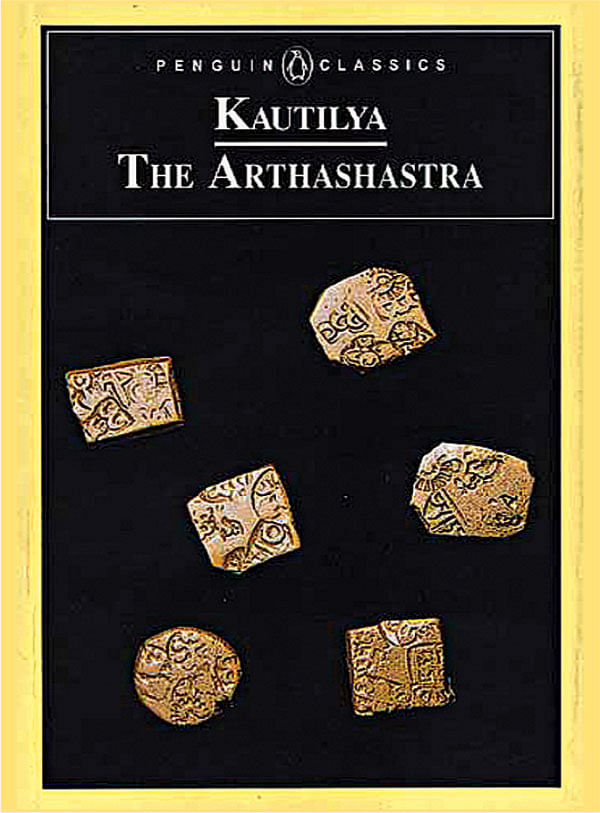CHANAKYA<br>The Philosopher of a Civilization

Around the time of Aristotle and Alexander in Greece, another philosopher and another king were building a civilization in our part of the world, South Asia. The philosopher was Vishnugupta, also known as Chanakya and Kautilya. The emperor was Chandragupta, the founder of the Mourya Empire. Chanakya's Kautilya Arthashastra ranks with works such as Plato's Dialogues and Sun Tsu's Art of War. Alas! Written 2,300 years ago,
Arthashastra got lost. Fortunately, it was re-discovered in 1905. Arthashastra makes us appreciate the genius of Chanakya and the civilization he represented.

Chanakya lived between 370 BC and 283 BC. He was educated at Takshashila (Taxila), in today's Pakistan. Taxila was the Oxford, Cambridge, and Harvard of its time. After teaching at Taxila, he moved to Pataliputra in Bihar in today's India. Pataliputra was the capital of the Nanda Kingdom. At its peak, it stretched from Punjab in the West to Bengal in the East. However, it wasn't an empire. Eager to establish himself in the Nanda court, Chanakya was humiliated by the Nanda King. Chanakya tied the knot in his hair. He swore not to open it until the Nanda Kingdom was destroyed. He found Chandragupta, the son of one of the royal wives. With Chanakya's shrewd strategies and Chandragupta's royal blood, the first empire of South Asia was established, the Mourya Empire. Chanakya went on to serve Chandragupta and his Son, Bindusara. The Mourya Empire remains the largest ever in South Asia. At its peak, under Ashok the Great, it stretched from Afghanistan to the boundaries of China in the Himalayas. It covered almost all of South India. Today's Bangladesh was a part of the Mourya Empire.
Chanakya's legacy remains in Kautilya Arthashastra. It's a book on how to run an empire (state). Chanakya understood the opportunistic and self-interested behaviour of people. He also appreciated the pragmatic role of the ruler who in ancient times also represented the state. His analysis was simple and universal. This is why Chanakya remains fresh even today.
Agriculture and trade were the main sources of economic activity. The role of the ruler (state) was to enter into these activities only in bad and immoral times. In times of prosperity, farmers and traders would know what to do. Pragmatism: control markets only when needed. Chanakya advocated trade to discourage neighbouring kingdoms to enter into war. In taxation, 'good timing' and 'convenience' were to be followed. Students of economics, do you hear Adam Smith's Wealth of Nations (1776), David Ricardo's Principles of Political Economy and Taxation (1817) and John Keynes's General Theory (1936)? Do you see the centuries old debate of the free market and the state? Economics is only one dimension. Governance is another crucial one.
Chanakya's ruler had two faces. The ruler needed to be ruthless to protect the fate and destiny of his kingdom and at the same time appear magnanimous as a role model for those within and outside his kingdom. The ruler was like Longfellow's little girl who had a little curl right in the middle of her forehead. She was very good and also she was very horrid. Students of politics, do you see a combination of Niccolo Machiavelli's Prince (1532), Thomas Hobbes's Leviathan (1651) and John Locke's Two Treatise of Government (1689)? Do you see the centuries old debate of what is the face of the government? There's still more to Chanakya. Only recently have social scientists coined the phrase Principal-Agent Problem: the classic problem of the mice (managers) playing when the cat (owner) is away. Chanakya was very much aware of opportunistic behaviour of those beneath the king. He was also a master strategist in the art of spy and war craft; second only to probably the Great Sun Tsu of ancient China.
The Mourya Civilization of antiquity was contemporary to the Greece of Alexander the Great and the Persia of Cyrus the Great. Chanakya remains the philosopher of this ancient civilization like Confucius was of ancient China. What Chanakya thought, others re-discovered independently centuries later. It does make you happy to know that Chanakya was one of us and that his teachings now belong to the world like all great worldly philosophers.
Asrar Chowdhury teaches economic theory and game theory in the classroom. Outside he listens to music and BBC Radio; follows Test Cricket; and plays the flute. He can be reached at: [email protected]

 For all latest news, follow The Daily Star's Google News channel.
For all latest news, follow The Daily Star's Google News channel. 



Comments